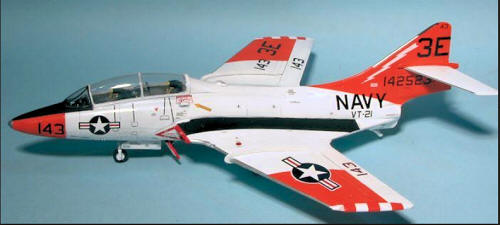Slipping the Bonds
by George Paterson
F9F-8T Cougar-VT21-sv3
The Grumman Cougar was derived from
the straight winged F9F-2 Panther, with swept wings and tailplane. The earliest
Cougar was the F9F-6, but the main production version was the F9F-8 with a
broader wing, and the tapered fillet at the root of the wing extended back right
to the tailpipe. The F9F-8 had a larger fuel capacity than the F-6. More than
700 F-8's were produced, and for a time it was the mainstay of the Navy's
fighter arm, though it was never used in combat.
The F9F-8T was a two-seat trainer
version, and it did see combat, in the Vietnam war. The US Marines used it as an
airborne control and command aircraft, directing airstrikes against enemy
positions in South Vietnam in 1966 and 1968. In that role, the F9F-8T was
finished in standard grey and white Navy camo, whereas the aircraft used by
training squadrons were finished in white, with extensive areas of bright red on
the nose and tail, and on the outer wings.
The Initial Image
 This model is by Scott van Aken,
and comes from the Kitty Hawk 1:48 kit. His review has ten photos of the model,
all taken against a light blue background. In as far as the background
influences the quality of the nominally white camo, it's beneficial for any
later pasting to a skyscape.
This model is by Scott van Aken,
and comes from the Kitty Hawk 1:48 kit. His review has ten photos of the model,
all taken against a light blue background. In as far as the background
influences the quality of the nominally white camo, it's beneficial for any
later pasting to a skyscape.
The definition is good, with a
little softness on the starboard wingtip that won't give me selection problems.
Scott's text is pretty positive
about the quality of this kit, and having crawled all over the airframe myself
in making my version, I too was impressed.
Treatment of the Image
This image has the canopy in its
closed position, so I had no difficulty on that score, and the selection of the
structure elements was soon finished.
The details I wanted to select
within each element were more tricky, especially on the white areas. I wasn't
easy to get some modelling in those areas.
 Selection
of the numerous markings was tedious but not difficult – except perhaps for the
complicated red warning decal at the rear of the canopy.
Selection
of the numerous markings was tedious but not difficult – except perhaps for the
complicated red warning decal at the rear of the canopy.
I pasted the finished airframe
image onto a background which is basically blue, but with a rather yellowish
cast; I had earlier tried pasting to some more blue backings, and found that
this one looked better to my eye.
Next I set about creating a
secondary airframe to accompany my primary. The main thing I needed to do was to
reduce the perspective effect on this more remote aircraft, but of course the
markings had to be revised as well.
Conclusions
These trainer Gougars are very
popular with modellers; I found five more model reviews of the white/red planes.
The less spectacular US Marine Cougars are also popular, because of the allure
of aircraft that were actively involved in combat situations. I found five
reviews of them, and some of them may be capable of giving me good in-flight
pictures.
Watch this space!
 This model is by Scott van Aken,
and comes from the Kitty Hawk 1:48 kit. His review has ten photos of the model,
all taken against a light blue background. In as far as the background
influences the quality of the nominally white camo, it's beneficial for any
later pasting to a skyscape.
This model is by Scott van Aken,
and comes from the Kitty Hawk 1:48 kit. His review has ten photos of the model,
all taken against a light blue background. In as far as the background
influences the quality of the nominally white camo, it's beneficial for any
later pasting to a skyscape.